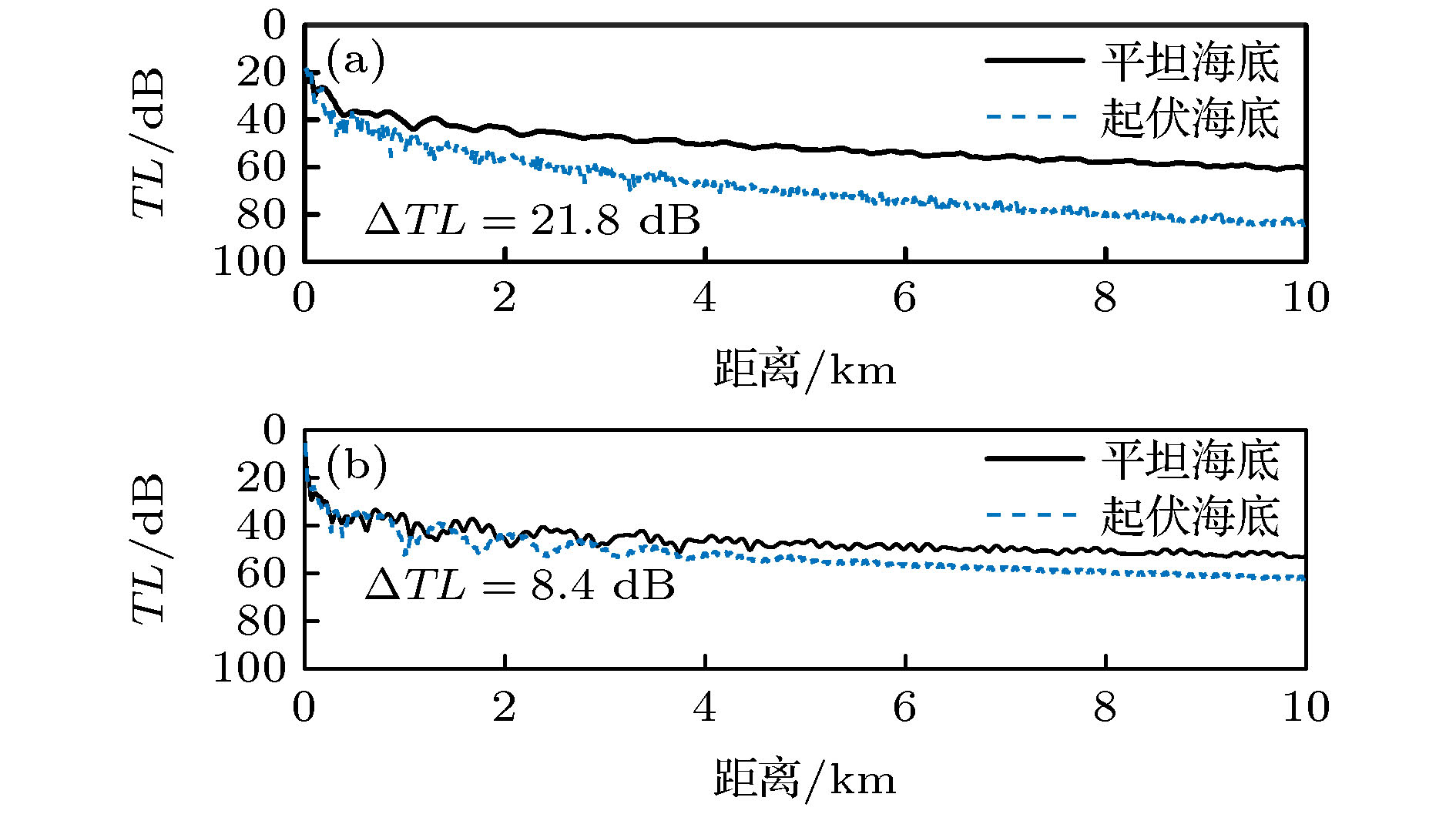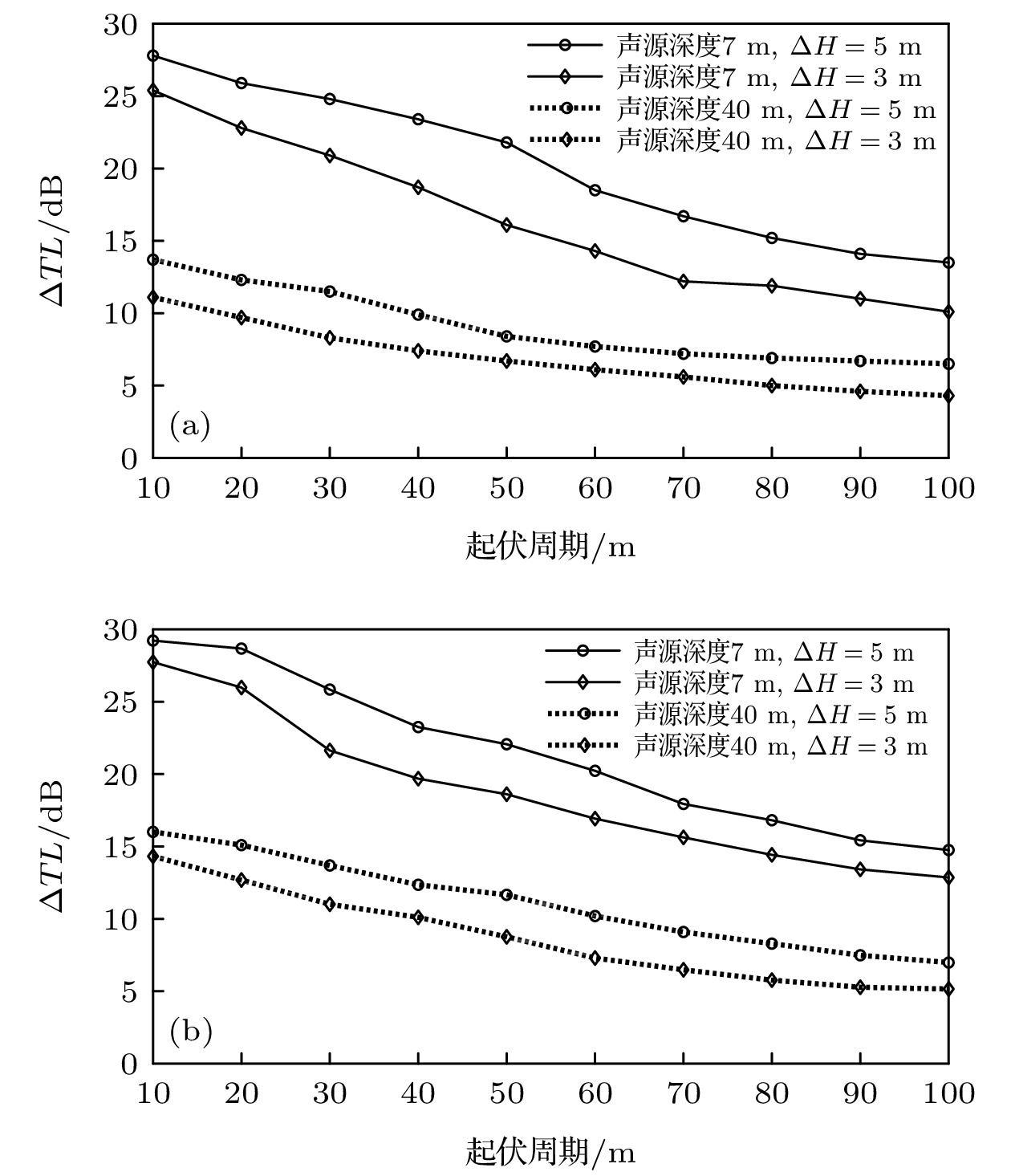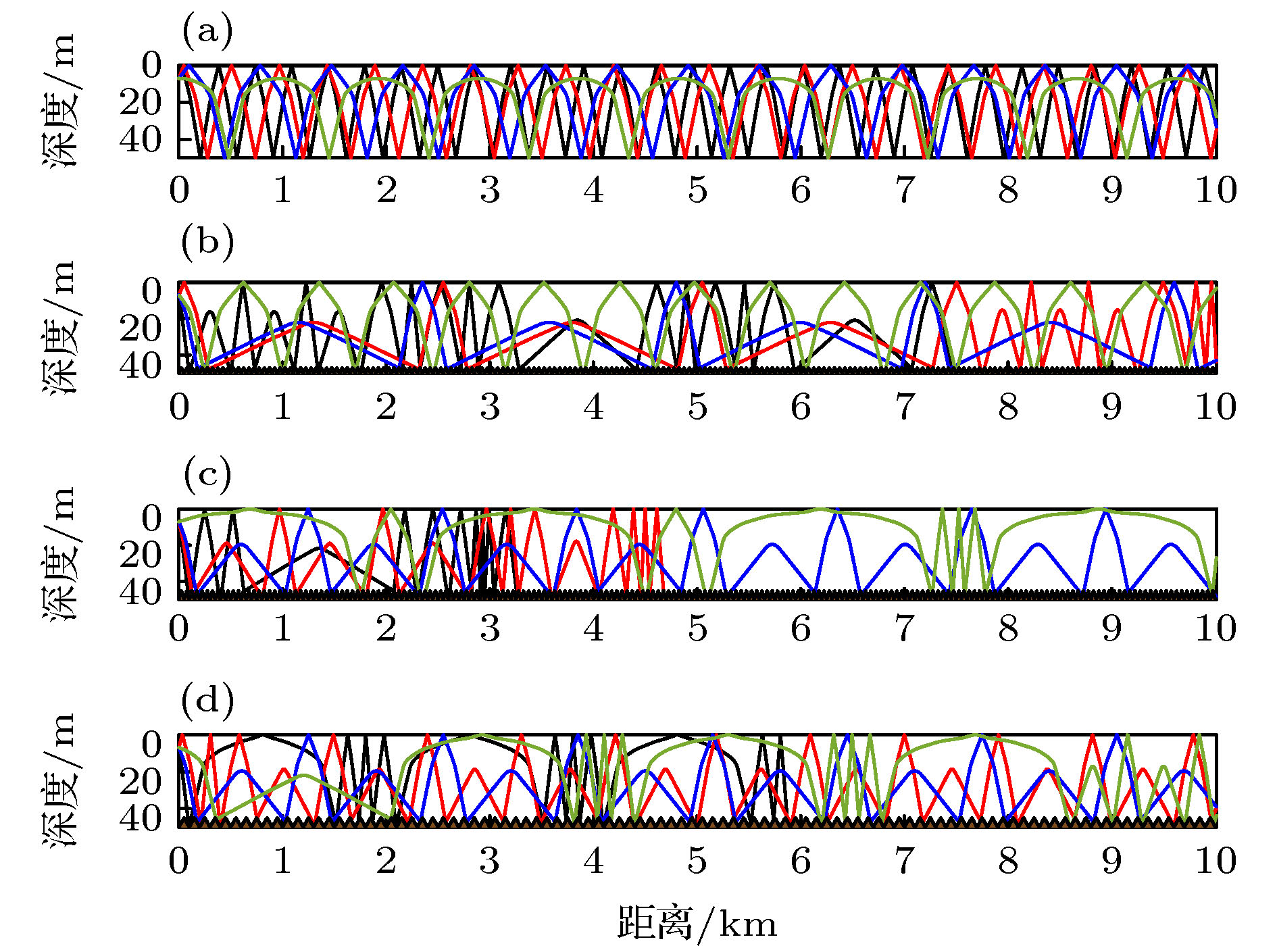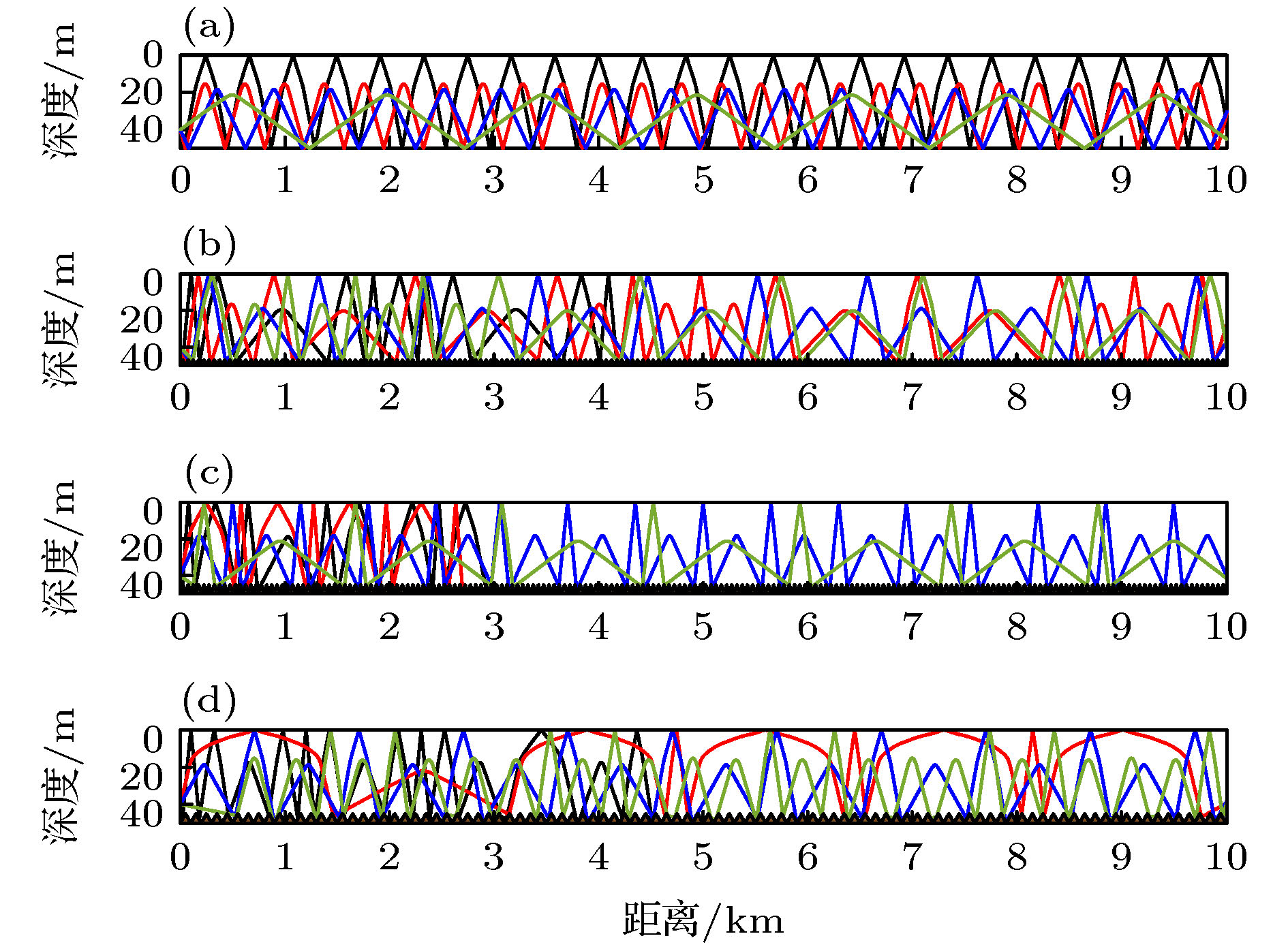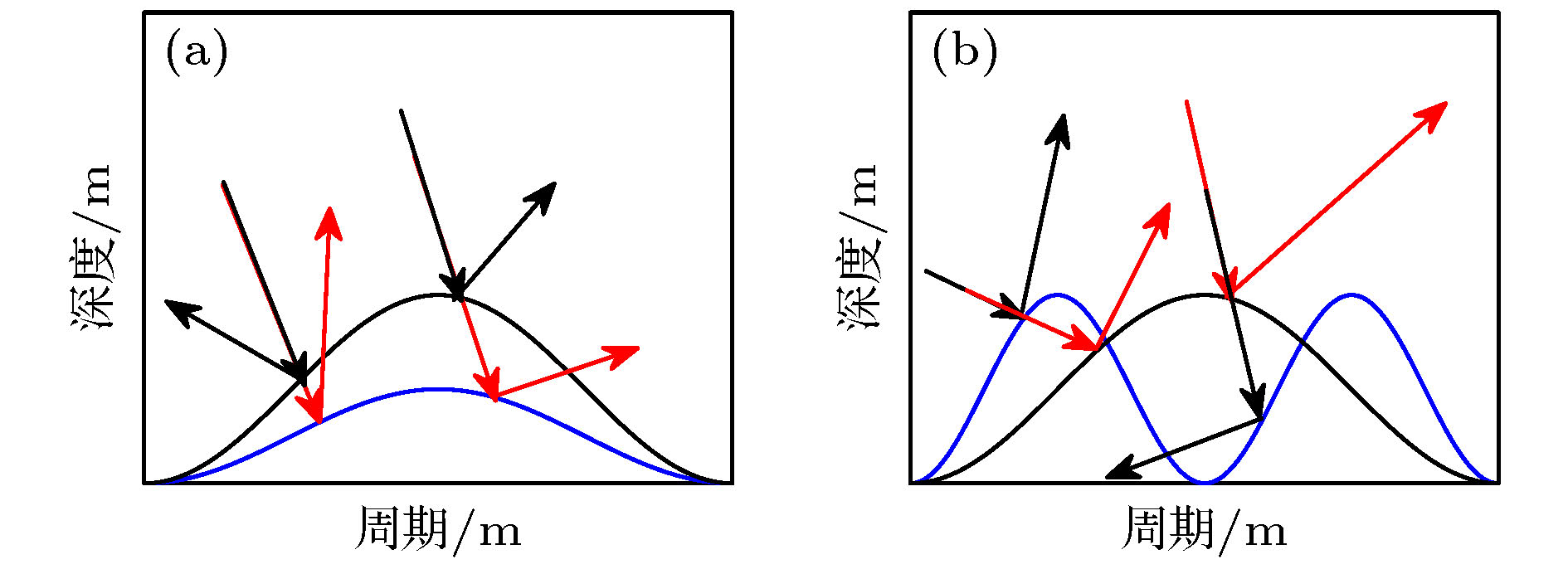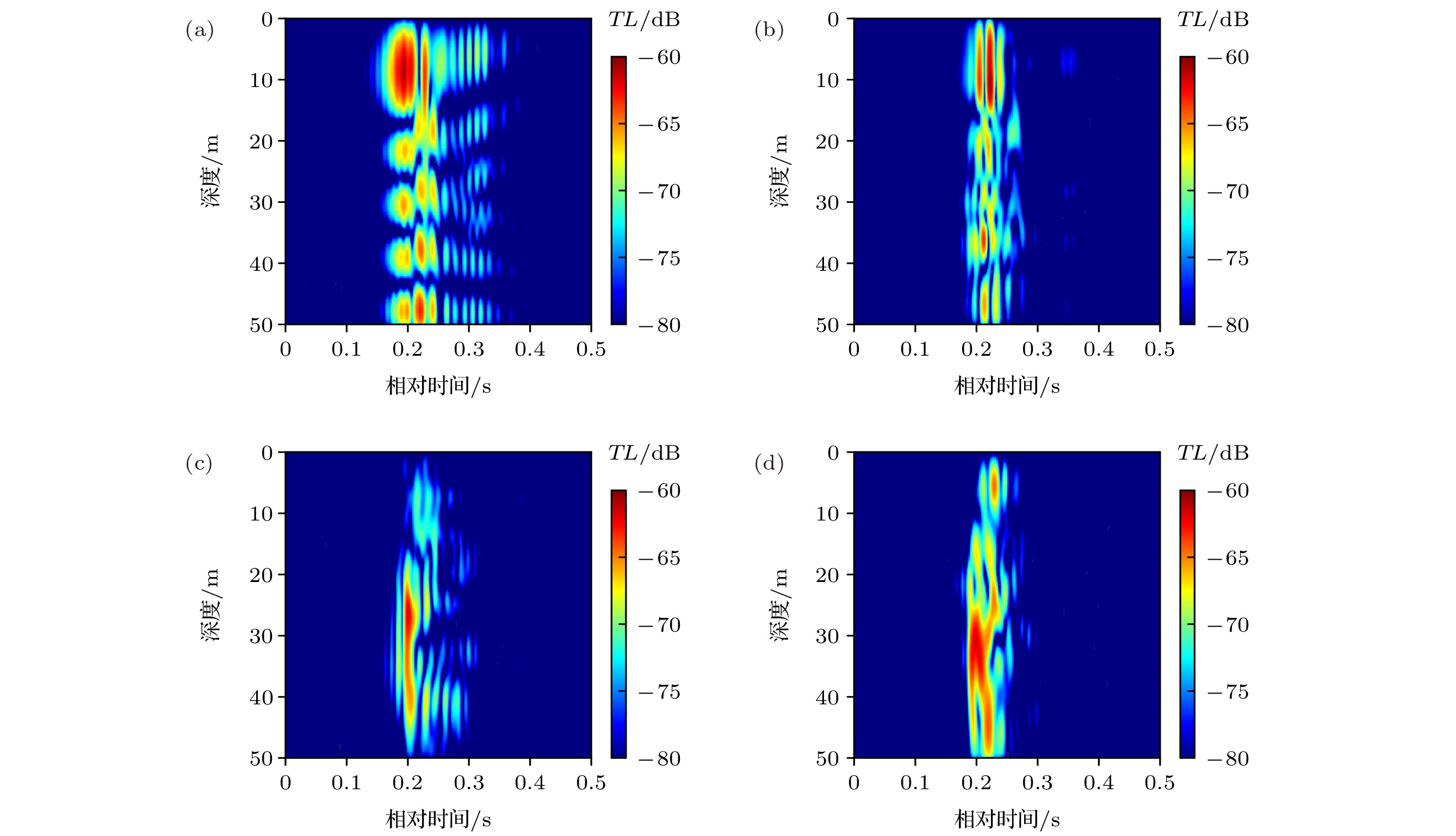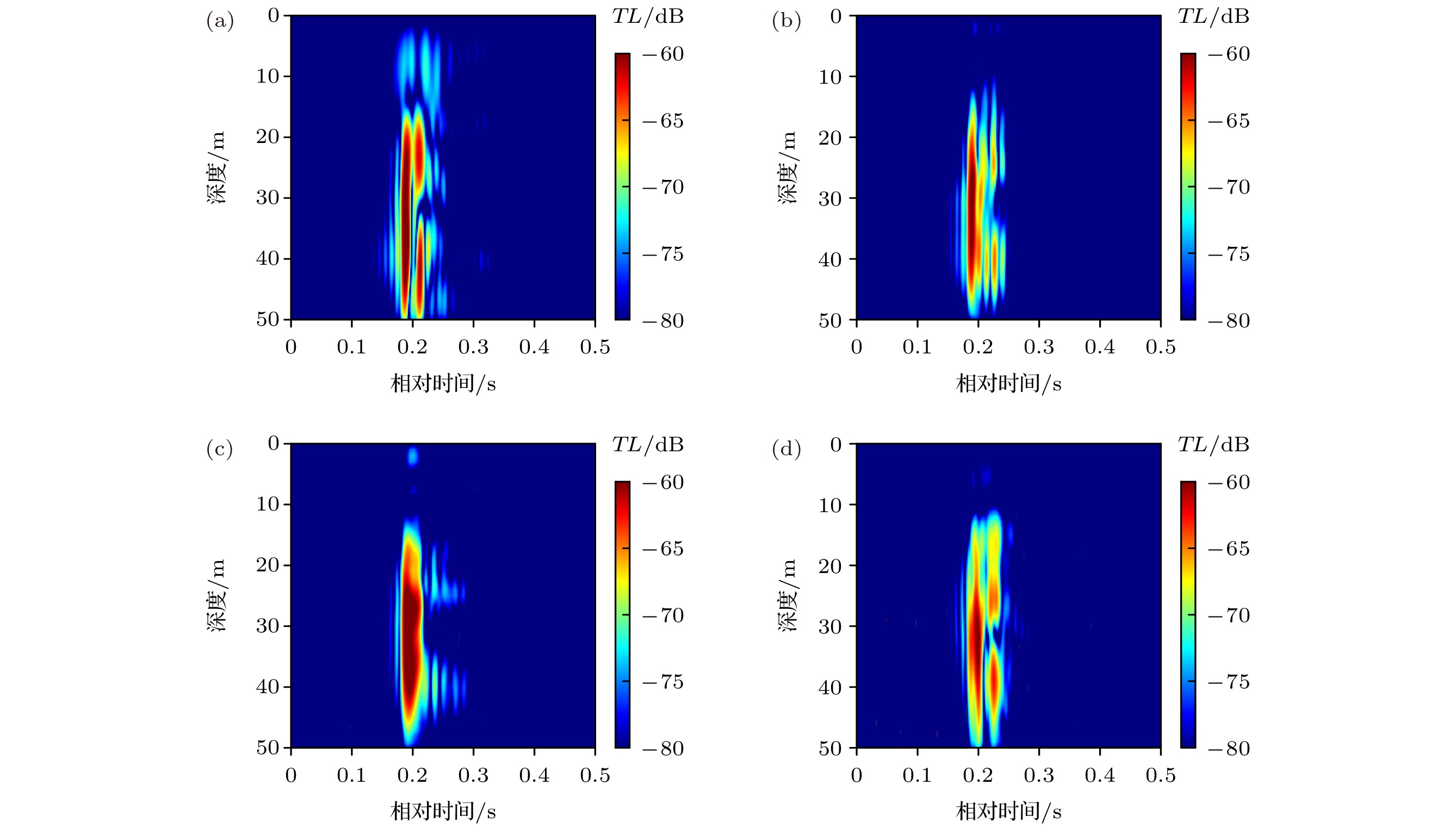-
海底粗糙对水下声传播及水声探测等应用具有重要影响. 利用黄海夏季典型海洋环境, 分析了同时存在海底周期起伏和强温跃层条件下的声传播特性, 结果表明: 由于海底周期起伏的存在, 对于低频(< 1 kHz)、近程(10 km)的声信号, 传播损失可增大5—30 dB. 总结了声传播损失及脉冲到达结构随声源深度、海底起伏周期及起伏高度等因素变化的规律. 当海底起伏周期不变时, 起伏高度越大引起的异常声传播的影响随之变大; 当起伏高度不变时, 随着起伏周期变大, 其对声传播的影响逐渐变小. 用射线理论分析了其影响机理, 由于海底周期起伏改变了声波与海底的入射和反射角度, 使得原本小掠射角入射到海底的声线变为大掠射角, 导致海底的反射损失增大; 另一方面, 声线反射角度的改变会使得原本可以到达接收点的声能量, 由于与海底作用次数增加或变为反向传播而大幅度衰减. 在浅海负跃层环境下, 声源位于跃层上比位于跃层下对声传播影响更大. 周期起伏海底对脉冲声传播的影响表现在引起不同角度的声线(或简正波号数)之间的能量发生转化, 一些大角度声线能量衰减加大, 多途结构变少. 多途结构到达时间及相对幅度的变化进而影响声场的频谱, 会使得基于匹配场定位的方法性能受到影响. 所以, 声呐在实际浅海环境中应用时, 应对起伏海底的影响予以重视. 此外, 研究结果对海底地形测绘空间精度的提高也具有重要参考意义.The rough sea bottom has a large effect on underwater acoustic propagation and underwater acoustic detection applications. By using the typical shallow water environment from the Yellow Sea, the acoustic propagation characteristics under the condition of both periodic rough sea bottom and strong negative thermocline layer are systematically analyzed by using the parabolic equation model RAM (where RAM stands for range-dependent acoustic model) and ray theory. For a low-frequency and short-range acoustic source, the transmission loss (TL) increases up to about 5–30 dB due to the existence of the periodic rough bottom. Abnormal TLs and pulse arrival structures with different source depths, different periods and heights of the rough bottom are analyzed and summarized. Specifically, when the period of the rough bottom is constant, TL increases with the height of the rough bottom increasing. When the height of the rough bottom is constant, the effect of the rough bottom on the sound propagation becomes smaller with the increase of the period. The mechanism of the TL difference caused by rough bottom is explained by using the ray theory. The incidence and reflection angle of the sound ray on the sea bottom are changed due to the periodic rough bottom, which makes small grazing angles of some of the rays incident at sea bottom become large grazing angles, and the bottom loss increases. On the other hand, the change of the reflection angle increases the number of ray interaction with the sea bottom, causing the reversion propagation. Therefore, the energy of the sound field will attenuate with range increasing. The influence of the periodic rough bottom on the sound pulse propagation is mainly reflected in the energy conversion between sound rays (or normal modes) with different angles, the increasing of energy attenuation of some sound rays with large angles, and the decreasing of multipath structure. The change of the arrival time and relative amplitude of the multipath structure affect the frequency spectrum of the sound field, which will affect the performance of the method based on matching field localization. Most of existing studies focus on the influence of the change in large scale sea bottom topography on the sound field, but there are few studies on small scale periodic sea bottom fluctuations, and the relevant summary of the law of sound propagation is lacking. When sonar is used in the actual shallow water environment, more attention should be paid to the influence of the periodic rough bottom. In addition, the present research results also have important reference significance for the spatial accuracy of surveying and mapping of sea bottom topography.
-
Keywords:
- negative thermocline environment /
- periodic rough sea bottom /
- abnormal sound propagation /
- characteristics of sound pulse propagation
[1] 鲍里斯·卡茨内尔松, 瓦莱里·佩提尼科夫, 詹姆斯·林奇 著 (程广利, 张亚蕾 译) 2012 浅海声学原理 (北京: 电子工业出版社)第7页
Katsnelson B, Petnikov V, Lynch J (translated by Cheng G L, Zhang Y L) 2012 Fundamentals of Shallow Water Acoustics (Beijing: Electronic Industry Press) p7 (in Chinese)
[2] 艾特P C 著 (蔡志明 译) 2005 水声建模与仿真 (北京: 电子工业出版社) 第44页
Etter P C (translated by Cai Z M) 2005 Underwater Acoustic Modeling and Simulation (Beijing: Electronic Industry Press) p44 (in Chinese)
[3] Urick R J 1954 J. Acoust. Soc. Am. 26 231
 Google Scholar
Google Scholar
[4] McKinney C M, Anderson C 1964 J. Acoust. Soc. Am. 36 158
 Google Scholar
Google Scholar
[5] Jackson D R, Baird A M, Crisp J J, Thomson P A G 1986 J. Acoust. Soc. Am. 80 1188
 Google Scholar
Google Scholar
[6] Lyons A P, Anderson A L, Dwan F S 1995 J. Acoust. Soc. Am. 95 2441
 Google Scholar
Google Scholar
[7] 李整林 2002 博士学位论文 (北京: 中国科学院声学研究所)
Li Z L 2002 Ph. D. Dissertation (Beijing: The institute of Acoustics of the Chinese Academy of Sciences) (in Chinese)
[8] Chiu L Y, Chang A Y 2014 J. Acoust. Soc. Am. 136 EL376
 Google Scholar
Google Scholar
[9] Li W, Li Z L, Zhang R H, Qin J X, Li J, Nan M X 2015 Chin. Phys. Lett. 32 064302
 Google Scholar
Google Scholar
[10] 胡治国, 李整林, 张仁和, 任云, 秦继兴, 何利 2016 物理学报 65 014303
 Google Scholar
Google Scholar
Hu Z G, Li Z L, Zhang R H, Ren Y, Qin J X, He L 2016 Acta. Phys. Sin. 65 014303
 Google Scholar
Google Scholar
[11] 梁民帅, 郁高坤, 彭临慧 2019 全国声学大会 中国深圳 9月20—23日, 1999 p123
Liang M S, Yu G K, Peng L H 2019 Acoustical Society of China Shenzhen, China, September 20-23, 2019 p123 (in Chinese)
[12] 董阳, 朴胜春, 龚李佳 2020 哈尔滨工程大学学报 10 1
 Google Scholar
Google Scholar
Dong Y, Piao S C, Gong L J 2020 J. Harbin Eng. Univ. 10 1
 Google Scholar
Google Scholar
[13] Dacol D K 1990 J. Acoust. Soc. Am. 88 978
 Google Scholar
Google Scholar
[14] Broschat S L, Thorsos E I 1997 J. Acoust. Soc. Am. 101 2615
 Google Scholar
Google Scholar
[15] Jackson D 2013 J. Acoust. Soc. Am. 133 3251
 Google Scholar
Google Scholar
[16] 彭朝晖, 周纪浔, 张仁和 2004 中国科学: 物理学 力学 天文学 34 304
 Google Scholar
Google Scholar
Peng Z H, Zhou J X, Zhang R H 2004 Sci. Sin.: Phys. Mech. Astron. 34 304
 Google Scholar
Google Scholar
[17] Ivakin A N, Lysanov Y P 1981 Sov Phys Acoust 27 212
[18] Liu R Y, Li Z L 2019 Chin. Phys. B 28 014302
 Google Scholar
Google Scholar
[19] Li Z L, Zhang R H 2004 Chin. Phys. Lett. 21 1100
 Google Scholar
Google Scholar
[20] Jensen F B, Kuperman W A, Porter M B, Schmidt H 2011 Computational Ocean Acoustics (2nd Ed.) (New York: Springer) pp463, 458
[21] Collins M D, Westwood E K 1991 J. Acoust. Soc. Am. 89 1068
 Google Scholar
Google Scholar
[22] Collins M D 1993 J. Acoust. Soc. Am. 93 1736
 Google Scholar
Google Scholar
[23] Collins M D 1994 J. Acoust. Soc. Am. 96 382
 Google Scholar
Google Scholar
[24] 李整林, 张仁和, Mohsen Badiey, Luo Jing 2011 声学学报 36 559
 Google Scholar
Google Scholar
Li Z L, Zhang R H, Mohsen Badiey, Luo J 2011 Acta. Acust. 36 559
 Google Scholar
Google Scholar
-
图 5 声源深度7 m时声线图 (a) 平坦海底; (b) 起伏周期为50 m (10λ)、起伏高度为3 m; (c) 起伏周期为50 m (10λ)、起伏高度为5 m; (d) 起伏周期为100 m (20λ)、起伏高度为5 m
Fig. 5. Rays for source above the thermocline (7 m) with different periodic rough bottom: (a) Flat sea bottom; (b) L = 50 m (10λ), ΔH = 3 m; (c) L = 50 m (10λ), ΔH = 5 m; (d) L = 100 m (20λ), ΔH = 5 m.
图 6 声源深度40 m时声线图 (a) 平坦海底; (b) 起伏周期为50 m (10λ)、起伏高度为3 m; (c) 起伏周期为50 m (10λ)、起伏高度为5 m; (d) 起伏周期为100 m (20λ)、起伏高度为5 m
Fig. 6. Rays for source below the thermocline (40 m) with different periodic rough bottom: (a) Flat sea bottom; (b) L = 50 m (10λ), ΔH = 3 m; (c) L = 50 m (10λ), ΔH = 5 m; (d) L = 100 m (20λ), ΔH = 5 m.
图 8 声源位于跃层上(7 m)时脉冲到达结构随深度变化(收发距离为10 km) (a)平坦海底; (b) 起伏周期为50 m (10λ)、起伏高度为3 m; (c) 起伏周期为50 m (10λ)、起伏高度为5 m; (d) 起伏周期为100 m (20λ)、起伏高度为5 m
Fig. 8. Arrival pulses at different receiver depths for the source above the thermocline (7 m): (a) Flat sea bottom; (b) L = 50 m (10λ), ΔH = 3 m; (c) L = 50 m (10λ), ΔH = 5 m; (d) L = 100 m (20λ), ΔH = 5 m.
图 9 声源位于跃层下(40 m)时脉冲到达结构随深度变化(收发距离为10 km) (a) 平坦海底; (b) 起伏周期为50 m (10λ)、起伏高度为3 m; (c) 起伏周期为50 m (10λ)、起伏高度为5 m; (d) 起伏周期为100 m (20λ)、起伏高度为5 m
Fig. 9. Arrival pulses at different receiver depths for the source below the thermocline (40 m): (a) Flat sea bottom; (b) L = 50 m (10λ), ΔH = 3 m; (c) L = 50 m (10λ), ΔH = 5 m; (d) L = 100 m (20λ), ΔH = 5 m.
图 10 声源位于跃层上(7 m)时各接收深度频谱图(收发距离为10 km) (a) 平坦海底; (b)起伏周期为50 m (10λ)、起伏高度为3 m; (c) 起伏周期为50 m (10λ)、起伏高度为5 m; (d) 起伏周期为100 m (20λ)、起伏高度为5 m
Fig. 10. Spectrogram at different receiver depths for the source above the thermocline (7 m): (a) Flat sea bottom; (b) L = 50 m (10λ), ΔH = 3 m; (c) L = 50 m (10λ), ΔH = 5 m; (d) L = 100 m (20λ), ΔH = 5 m.
图 11 声源位于跃层下(40 m)时各接收深度频谱图(收发距离为10 km) (a) 平坦海底; (b) 起伏周期为50 m (10λ)、起伏高度为3 m; (c) 起伏周期为50 m (10λ)、起伏高度为5 m; (d) 起伏周期为100 m (20λ)、起伏高度为5 m
Fig. 11. Spectrogram at different receiver depths for the source below the thermocline (40 m): (a) Flat sea bottom; (b) L = 50 m (10λ), ΔH = 3 m; (c) L = 50 m (10λ), ΔH = 5 m; (d) L = 100 m (20λ), ΔH = 5 m.
-
[1] 鲍里斯·卡茨内尔松, 瓦莱里·佩提尼科夫, 詹姆斯·林奇 著 (程广利, 张亚蕾 译) 2012 浅海声学原理 (北京: 电子工业出版社)第7页
Katsnelson B, Petnikov V, Lynch J (translated by Cheng G L, Zhang Y L) 2012 Fundamentals of Shallow Water Acoustics (Beijing: Electronic Industry Press) p7 (in Chinese)
[2] 艾特P C 著 (蔡志明 译) 2005 水声建模与仿真 (北京: 电子工业出版社) 第44页
Etter P C (translated by Cai Z M) 2005 Underwater Acoustic Modeling and Simulation (Beijing: Electronic Industry Press) p44 (in Chinese)
[3] Urick R J 1954 J. Acoust. Soc. Am. 26 231
 Google Scholar
Google Scholar
[4] McKinney C M, Anderson C 1964 J. Acoust. Soc. Am. 36 158
 Google Scholar
Google Scholar
[5] Jackson D R, Baird A M, Crisp J J, Thomson P A G 1986 J. Acoust. Soc. Am. 80 1188
 Google Scholar
Google Scholar
[6] Lyons A P, Anderson A L, Dwan F S 1995 J. Acoust. Soc. Am. 95 2441
 Google Scholar
Google Scholar
[7] 李整林 2002 博士学位论文 (北京: 中国科学院声学研究所)
Li Z L 2002 Ph. D. Dissertation (Beijing: The institute of Acoustics of the Chinese Academy of Sciences) (in Chinese)
[8] Chiu L Y, Chang A Y 2014 J. Acoust. Soc. Am. 136 EL376
 Google Scholar
Google Scholar
[9] Li W, Li Z L, Zhang R H, Qin J X, Li J, Nan M X 2015 Chin. Phys. Lett. 32 064302
 Google Scholar
Google Scholar
[10] 胡治国, 李整林, 张仁和, 任云, 秦继兴, 何利 2016 物理学报 65 014303
 Google Scholar
Google Scholar
Hu Z G, Li Z L, Zhang R H, Ren Y, Qin J X, He L 2016 Acta. Phys. Sin. 65 014303
 Google Scholar
Google Scholar
[11] 梁民帅, 郁高坤, 彭临慧 2019 全国声学大会 中国深圳 9月20—23日, 1999 p123
Liang M S, Yu G K, Peng L H 2019 Acoustical Society of China Shenzhen, China, September 20-23, 2019 p123 (in Chinese)
[12] 董阳, 朴胜春, 龚李佳 2020 哈尔滨工程大学学报 10 1
 Google Scholar
Google Scholar
Dong Y, Piao S C, Gong L J 2020 J. Harbin Eng. Univ. 10 1
 Google Scholar
Google Scholar
[13] Dacol D K 1990 J. Acoust. Soc. Am. 88 978
 Google Scholar
Google Scholar
[14] Broschat S L, Thorsos E I 1997 J. Acoust. Soc. Am. 101 2615
 Google Scholar
Google Scholar
[15] Jackson D 2013 J. Acoust. Soc. Am. 133 3251
 Google Scholar
Google Scholar
[16] 彭朝晖, 周纪浔, 张仁和 2004 中国科学: 物理学 力学 天文学 34 304
 Google Scholar
Google Scholar
Peng Z H, Zhou J X, Zhang R H 2004 Sci. Sin.: Phys. Mech. Astron. 34 304
 Google Scholar
Google Scholar
[17] Ivakin A N, Lysanov Y P 1981 Sov Phys Acoust 27 212
[18] Liu R Y, Li Z L 2019 Chin. Phys. B 28 014302
 Google Scholar
Google Scholar
[19] Li Z L, Zhang R H 2004 Chin. Phys. Lett. 21 1100
 Google Scholar
Google Scholar
[20] Jensen F B, Kuperman W A, Porter M B, Schmidt H 2011 Computational Ocean Acoustics (2nd Ed.) (New York: Springer) pp463, 458
[21] Collins M D, Westwood E K 1991 J. Acoust. Soc. Am. 89 1068
 Google Scholar
Google Scholar
[22] Collins M D 1993 J. Acoust. Soc. Am. 93 1736
 Google Scholar
Google Scholar
[23] Collins M D 1994 J. Acoust. Soc. Am. 96 382
 Google Scholar
Google Scholar
[24] 李整林, 张仁和, Mohsen Badiey, Luo Jing 2011 声学学报 36 559
 Google Scholar
Google Scholar
Li Z L, Zhang R H, Mohsen Badiey, Luo J 2011 Acta. Acust. 36 559
 Google Scholar
Google Scholar
计量
- 文章访问数: 12679
- PDF下载量: 269
- 被引次数: 0














 下载:
下载:
